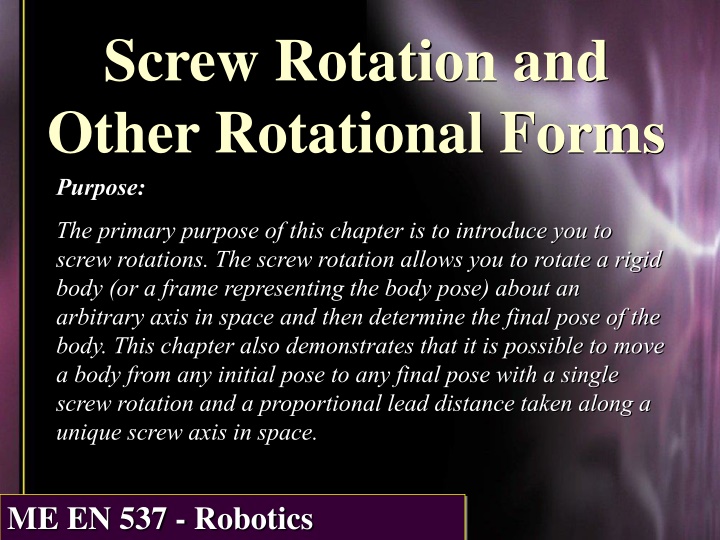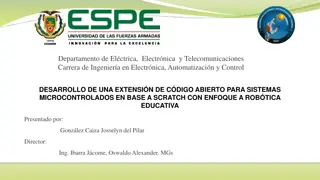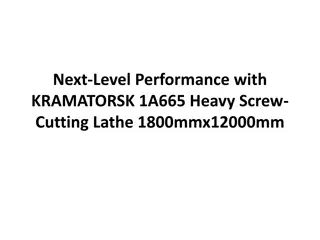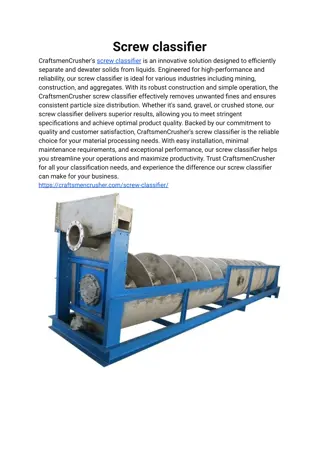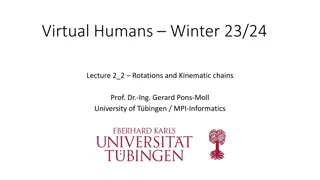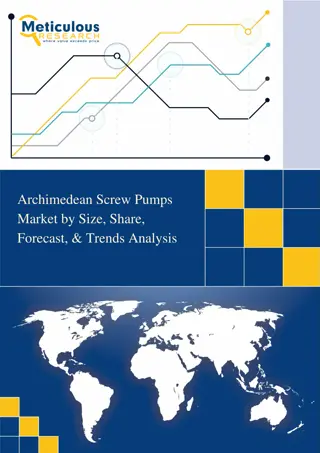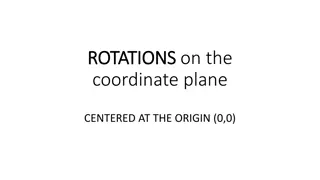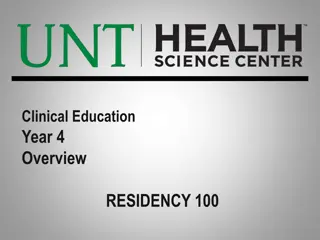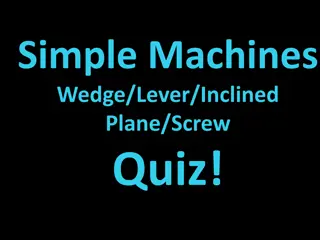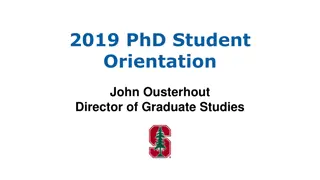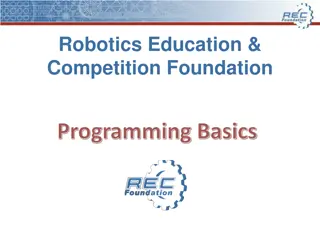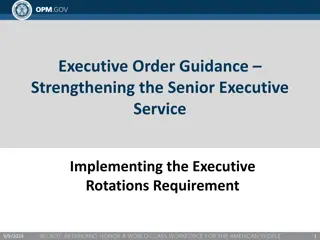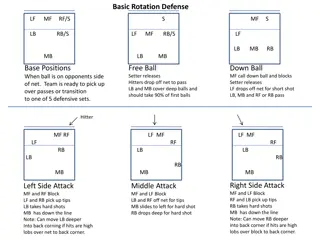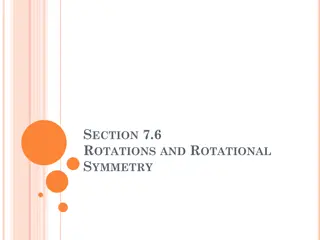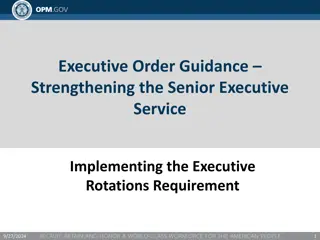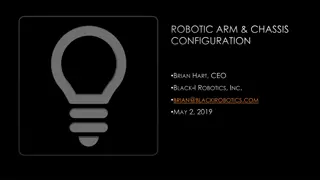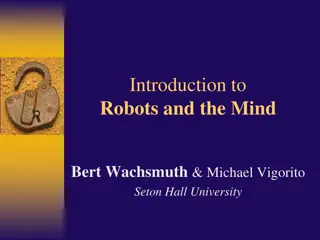Introduction to Screw Rotations in Robotics
This chapter introduces screw rotations, explaining how they enable rotating a rigid body about an arbitrary axis and determining its final pose. Explore the screw matrix form, derivation, inverse solutions, and extending it for displacement. Discover how a general location change is modeled with screw rotations and learn about Euler transformation sets.
Download Presentation

Please find below an Image/Link to download the presentation.
The content on the website is provided AS IS for your information and personal use only. It may not be sold, licensed, or shared on other websites without obtaining consent from the author.If you encounter any issues during the download, it is possible that the publisher has removed the file from their server.
You are allowed to download the files provided on this website for personal or commercial use, subject to the condition that they are used lawfully. All files are the property of their respective owners.
The content on the website is provided AS IS for your information and personal use only. It may not be sold, licensed, or shared on other websites without obtaining consent from the author.
E N D
Presentation Transcript
Screw Rotation and Other Rotational Forms Purpose: The primary purpose of this chapter is to introduce you to screw rotations. The screw rotation allows you to rotate a rigid body (or a frame representing the body pose) about an arbitrary axis in space and then determine the final pose of the body. This chapter also demonstrates that it is possible to move a body from any initial pose to any final pose with a single screw rotation and a proportional lead distance taken along a unique screw axis in space. ME 537 - Robotics ME EN 537 - Robotics
In particular, you will 1. Examine the form of the screw matrix (screw vector, screw angle). 2. See how it is derived. 3. Determine the inverse solution. 4. Extend the screw matrix to include displacement. 5. Prove that a general location change of a rigid body can be modeled as a single screw displacement (screw rotation about screw vector and translation along a screw axis). 6. Examine the Euler transformation set of three rotations. ME 537 - Robotics ME EN 537 - Robotics
Rotation About an Arbitrary Axis Rotation about an arbitrary axis through the base origin with direction described by the k unit vector (having components which are the direction cosines) can be determined by the transformation: kykxv - kzs ky2v + c kykzv + kxs kzkxv + kys kzkyv - kxs kz2v +c kx2v + c kxkyv + kzs kxkzv - kys R(k, ) = where kx, ky, and kz = direction cosines of k v = 1 - c s = sin c = cos (versine of ) ME 537 - Robotics ME EN 537 - Robotics
Rotation About an Arbitrary Axis Z k Y X ME 537 - Robotics ME EN 537 - Robotics
Screw matrix derivation The derivation method is summarily given in Chapter 2 of the reading material, but it follows these steps: Z Z We can resolve a vector originally in frame C after rotation H by the equation CHC-1, which can be shown to reduce to the screw matrix. Step 1 Step 2 z , z z k Y Y X X H describes rotation about z to double prime frame Prime frame described by C ME 537 - Robotics ME EN 537 - Robotics
Screw rotationsinverse problem Given the screw matrix R, what is the screw angle(s) and what is the screw vector(s) k? kykxv - kzs ky2v + c kykzv + kxs kzkxv + kys kzkyv - kxs kz2v +c kx2v + c kxkyv + kzs kxkzv - kys R(k, ) = In other words, find the 4 unknowns kx, ky, kz, and given 9 known elements of R. ME 537 - Robotics ME EN 537 - Robotics
Inverse solution Express the known 3 x 3 matrix R as R = [a b c]where a, b, and c are axes unit vectors expressed in their direction cosine components (e.g., ax, ay, az are the components of a). There are 9 matrix components that are known. First, sum the diagonal elements to eliminate the k unknowns. This gives the equation for cos = (ax + by + cz -1)/2 Unfortunately, this does not provide a unique . Why? ME 537 - Robotics ME EN 537 - Robotics
Inverse solution Next, difference pairs of off-diagonal terms to get ay - bx = 2 kz s cx - az = 2 ky s bz - cy = 2 kx s Now square and add, then solve for s to get Why the ? What does this mean? sin = 1 (ay- bx)2+ (cx- az)2+ (bz- cy)2 2 Use the atan2 function to get a unique . What is the atan2 function? ME 537 - Robotics ME EN 537 - Robotics
Inverse solution Now, given cos and sin , we determine that there are two solutions for and k. Can you explain this? What does it mean graphically? Which solution would you normally select? k k ME 537 - Robotics ME EN 537 - Robotics
Inverse solution Now, given , we determine the solutions for k: kz = ay - bx ky = cx - az kx = bz - cy 2 s 2 s 2 s It is suggested that the equations be renormalized after applying. But there are problems if is near 0 or 180 degrees! If too close to 0 or 180, a different solution should be applied. See the notes for this alternative solution approach. ME 537 - Robotics ME EN 537 - Robotics
Example Given the xyz frame is originally coincident with the base frame, what is the equivalent and minimum screw angle and the screw vector that will rotate it to the the orientation described by R? 0.933 0.067 0.354 Soln: R = 0.067 0.933 -0.354 = 30 deg k = [0.707 0.707 0] -0.354 0.354 0.866 ME 537 - Robotics ME EN 537 - Robotics
Screw displacement Hypothesis: It is possible to move any rigid body from an initial pose to a second pose in space by a single screw rotation and an additional translation along a unique screw axis that is parallel to the screw vector ME 537 - Robotics ME EN 537 - Robotics
y' S Z x' z' P' y p' d x p Y P k z q v X ME 537 - Robotics ME EN 537 - Robotics
Vector plane equation A plane can be located in space by the vector equation nTx = h where n is an outward vector normal to the plane n x = any point in the plane h origin of the frame of reference. h = minimum distance of the plane ME 537 - Robotics ME EN 537 - Robotics
Vector plane equation cases Examine the form of the equation d = nTx h If x is in the plane, then d = 0. If x is a point not in the plane, then d 0 , where d > 0 if x is on the positive side of the plane (on the side of the outward normal) and d < 0 if on the negative side of the plane. Thus, given the plane equation, it is easy to determine the perpendicular distance of any point in space from the plane. ME 537 - Robotics ME EN 537 - Robotics
Screw displacement solution Suppose C is a known homogeneous transformation that locates frame xyz (body frame) relative to XYZ, while C locates frame x y z (body frame at new location) relative to XYZ. Determine the screw axis (q and k), lead distance (d), and screw rotation ( ) ) that will accomplish the screw displacement of the body. ME 537 - Robotics ME EN 537 - Robotics
Screw displacement solution P and P' represent a point in the body being displaced to a different location. The screw translation (lead distance) can be calculated by projecting P' onto a plane to k containing point P. The simplest approach is to place the origin of the xyz frame at P (thus, p = 0), and also allow the plane to k to contain P. By choosing XYZ to be the same as xyz, C becomes an identity matrix while C poses the body in its final location relative to its initial location. ME 537 - Robotics ME EN 537 - Robotics
Screw displacement solution k and are determined using the rotational sub- matrix of C and the screw vector solution equations presented earlier! Now we need only determine d and q. ME 537 - Robotics ME EN 537 - Robotics
Screw displacement solution The screw translation distance d can be calculated from the projection distance of P' onto the defined plane by d = kT p' (d is one of required parameters) where h will be zero (why?). The projection point is calculated from v = p' - d k ME 537 - Robotics ME EN 537 - Robotics
Screw displacement solution Now given p = 0 and p', q can be located in the XYZ (or xyz) axes by referring to the following figure, a normal view of the plane of interest . q r q p p a r e e L/2 a L L/2 v v ME 537 - Robotics ME EN 537 - Robotics
Screw displacement solution Now, L = | v | If 0 < < 180 then can be located by determining the unit vector normal to the vector v and lying in the plane. Call this unit vector ea where a is the minimum distance between q and the vector v. a is determined from a = L 2 / tan 2 ME 537 - Robotics ME EN 537 - Robotics
Screw displacement solution ea is defined by ea = k x eL = k x v /L Given ea, q is determined by q = a ea + v /2 (q is final parameter) This completes the simplified solution. A more extensive solution is presented in the course notes for the case where xyz is not aligned with XYZ. ME 537 - Robotics ME EN 537 - Robotics
Euler transformation Euler angles describe any possible orientation by a sequence of 3 rotations, about z, about y', and about z" as shown in the figure . Note: Euler angles are used in aerospace industry to describe spacecraft and satellite motion. about z'', z''' about z, z' y''' about y' ,y" Roll, pitch, yaw transfor- mations as described in the course notes are used in the aircraft and shipping industries. y x x' x" x''' ME 537 - Robotics ME EN 537 - Robotics
Euler matrices Now any vector in w in x'"y'"z'" axes can be described in base xyz axes after rotations and by the following matrix operations. cos -sin 0 sin cos 0 0 0 1 cos 0 sin 0 1 0 -sin 0 cos cos -sin 0 sin cos 0 0 0 1 v = w u = v q = u ME 537 - Robotics ME EN 537 - Robotics
Euler matrices Thus, the coordinates q of point w in base xyz axes after rotations and are cos -sin 0 sin cos 0 0 0 1 cos -sin 0 sin cos 0 0 0 1 cos 0 sin 0 1 0 -sin 0 cos q = w c c c -s s -c c s -s c c s s c c + c s -s c s + c c s s -s c s s c q = w We could also work the inverse problem here by determining an Euler angle set to orient a body given a known orientation matrix. ME 537 - Robotics ME EN 537 - Robotics
Screw and other transformations summary The screw transformation, a special form of the rotational sub-matrix R, represents the rotation about an arbitrary axis that passes through the origin of the reference frame. A plane in space can be described by the simple equation nT x = d where n is the plane normal, x is any point in the plane, and d is the minimum distance of the plane from the reference frame origin. ME 537 - Robotics ME EN 537 - Robotics
Screw and other transformations summary It is possible to move a body from any initial pose to any final pose with a single screw rotation and a proportional lead distance taken along a unique screw axis in space. This is referred to as the screw displacement. Other transformations that are useful are Euler s angles and roll-pitch-yaw. Euler s angles are often used in the aerospace industries, whereas roll-pitch-yaw is used in the aircraft and shipping industries to describe the motion of rigid bodies. ME 537 - Robotics ME EN 537 - Robotics
